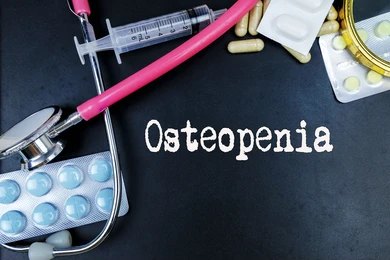Osteopenia: Symptoms, T‑Scores, Causes, Treatment & Prevention
Osteopenia means lower‑than‑normal bone mineral density (BMD). It’s not yet osteoporosis, but it signals higher fracture risk if bone loss continues. The good news: with the right plan—nutrition, exercise, fall prevention, and, when needed, medication—you can reduce risk and often improve BMD.
Definition: In post‑menopausal women and men aged 50+, osteopenia is defined by a DEXA T‑score between −1.0 and −2.5. For premenopausal women and men <50, clinicians rely more on Z‑scores (age‑matched).
Table of Contents
- Osteopenia vs. Osteoporosis vs. Osteomalacia
- Subtle Symptoms and Early Warning Signs
- Causes & Risk Factors
- Diagnosis (DEXA, T/Z‑scores, FRAX)
- Prevention & Management
- Medications (when indicated)
- Monitoring & Follow‑up
- FAQ
- References
Osteopenia vs. Osteoporosis vs. Osteomalacia
These conditions affect bones differently:
| Condition | Key Feature | Bone Density (T‑score) | Typical Cause |
|---|---|---|---|
| Osteopenia | Low bone mass; micro‑architecture generally intact. | −1.0 to −2.5 | Bone loss outpaces formation with age/hormonal changes. |
| Osteoporosis | Very low mass and fragile structure; high fracture risk. | ≤ −2.5 | Prolonged net bone loss; post‑menopause; aging; secondary causes. |
| Osteomalacia | Poor mineralization (“soft bone”), bone pain/weakness. | Variable | Often vitamin D deficiency; also calcium/phosphate deficiency, malabsorption, renal disease. |
Subtle Symptoms and Early Warning Signs
Osteopenia is usually silent. Possible red flags include:
- Fragility fractures from minor falls/impacts.
- Receding gums or jawbone loss seen on dental X‑rays.
- Brittle nails (nonspecific but sometimes associated).
- Loss of height/stooped posture from vertebral compression fractures.
- Reduced grip strength, correlating with lower overall BMD and fall risk.
- Deep bone aches/muscle cramps with vitamin D/calcium deficiency.
Causes & Risk Factors
Uncontrollable
- Female sex, especially post‑menopause
- Older age
- Family history of osteoporosis or hip fracture
- Low BMI/small body frame
- Ethnicity: higher risk in Caucasian and Asian populations
Controllable / Medical
- Low calcium/vitamin D intake; poor protein intake
- Smoking; excess alcohol; physical inactivity
- Endocrine disorders (hyperthyroidism, hyperparathyroidism, hypogonadism), celiac/malabsorption, chronic kidney disease, rheumatoid arthritis
- Medications: long‑term glucocorticoids, aromatase inhibitors, some anticonvulsants, PPIs, SSRIs, heparin (discuss risks with your clinician)
Diagnosis (DEXA, T/Z‑scores, FRAX)
- DEXA scan (hip/spine) is the gold standard. Quick, painless, very low radiation.
- T‑scores (post‑menopausal women/men ≥50): Normal ≥ −1.0; Osteopenia −1.0 to −2.5; Osteoporosis ≤ −2.5.
- Z‑scores (premenopausal women/men <50) compare BMD to age‑matched norms.
- FRAX 10‑year fracture risk: combines BMD + risk factors to guide treatment decisions. Calculate FRAX (India).
- Check for secondary causes with labs: 25(OH)D, calcium, phosphate, creatinine/eGFR, TSH, PTH, celiac serology; in men, morning testosterone. Review medications.
Prevention & Management
Nutrition
- Calcium (total from food + supplements): 1000 mg/day (men 19–70, women 19–50); 1200 mg/day (women 51+, men 71+). Avoid routinely >~2000 mg/day unless advised.
- Vitamin D3: Typically 800–1000 IU/day; target serum 25(OH)D ~30–50 ng/mL. Safe upper limit commonly 4000 IU/day unless your clinician advises otherwise.
- Protein: ~0.8–1.2 g/kg/day to support bone and muscle.
- Magnesium & vitamin K2: May help when combined with calcium/vitamin D—discuss supplementation with your clinician.
Exercise
- Resistance training 2–3x/week (8–10 exercises, 2–3 sets of 8–12 reps).
- Weight‑bearing/impact: brisk walking, stairs, light hops/jumps if safe.
- Balance/posture: yoga, Tai Chi, targeted balance drills.
Safety: With low BMD/vertebral risk, avoid deep loaded spinal flexion/twisting; learn hip‑hinge technique and progress under guidance.
Lifestyle & Fall Prevention
- Stop smoking; limit alcohol
- Optimize vision/footwear; remove home trip hazards; consider vitamin D repletion for fall risk
Medications (when indicated)
Treatment is individualized. Medicines are considered if you’ve had a fragility fracture, have osteoporosis (≤ −2.5), or have osteopenia with high FRAX risk (commonly ≥20% major or ≥3% hip over 10 years).
- Bisphosphonates: alendronate, risedronate, zoledronic acid
- Denosumab (RANKL inhibitor)
- Others (case‑by‑case): SERMs (raloxifene), menopausal hormone therapy; very high‑risk patients may need anabolic agents (teriparatide, abaloparatide, romosozumab). Always clinician‑guided.
Monitoring & Follow‑up
- Repeat DEXA every 1–2 years if high risk/on therapy; every 2–3 years if stable and low risk.
- Track height annually; investigate >2 cm loss.
- Review calcium/vitamin D status and exercise adherence regularly.
FAQ
Can osteopenia improve?
Yes—many people maintain or modestly increase BMD (often 1–3% over 12–24 months) with nutrition, resistance training, vitamin D repletion, and fall‑prevention. Some will need medication based on risk.
How often should I get a DEXA scan?
Usually every 1–2 years if high risk or on treatment; otherwise every 2–3 years. Your clinician will personalize timing.
Is osteopenia painful?
No. The condition itself is typically painless. Pain often comes from fractures or from deficiencies (e.g., vitamin D) that can cause bone aches and muscle cramps.
Do supplements replace diet and exercise?
No. Aim to meet most calcium/protein from food. Supplements fill gaps. Exercise (especially resistance and balance) is equally important for bone and fall risk.
When should I see a specialist?
If you have multiple risk factors, unusual or recurrent fractures, very low T‑scores, or complex medical conditions/medications, see an endocrinologist or bone health specialist.
Protect Your Bone Health
Don’t wait for a fracture. Start a personalized plan to protect bone density today.
Book a Bone Health ConsultationReferences
- Bone Health & Osteoporosis Foundation (BHOF)
- FRAX® 10‑Year Fracture Risk Calculator (India)
- Endocrine Society Guideline: Osteoporosis in Postmenopausal Women
- NIAMS/NIH: Osteoporosis & Bone Health
Disclaimer: This article is for information only and does not replace medical advice. Always consult a qualified clinician for diagnosis and treatment.

